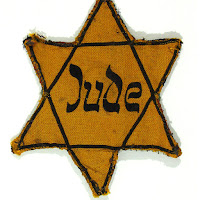When Carlos became king, Eleanor fell ill and repaired to Castile with their daughters; when she returned she found several mistresses and illegitimate children at the palace. Eleanor abruptly returned to Castile. Some suggest that she was afraid Lanzarot would have a better claim to the throne than her daughters, even though the laws of Navarre forbade it. I think it more likely that she was disgusted with her husband—their marriage was strictly political in execution—and wanted to be away from him.
Kings often treated their bastards well. Lanzarot was given a religious education along with a coat of arms (see illustration). In 1397 he was at a grammar school in Pamplona, and in 1403 he and his brother Godfrey went to the University of Toulouse. In that year Carlos had two archdeacons nominate Lanzarot to become a bishop, but Pope Benedict XIII would only allow Lanzarot to be an apostolic notary (essentially a document secretary) and an archdeacon of Calahorra in Castile. The Castilians objected.
In 1406 the See of Pamplona became vacant, and Carlos wanted Lanzarot in the position. The pope refused, and in 1407 Castile finally accepted Lanzarot as an archdeacon. Benedict was in Avignon, and this was the time of the Western Schism when there were three popes in contention for authority. When Pope Gregory XII in Rome started gaining the upper hand, Benedict decided he needed more allies and accepted Carlos' request. Lanzarot would still not be a bishop, but was made a vicar general to oversee Pamplona; the actual bishopric position remained vacant. Then, in 1418, he was made titular bishop of Alexandria.**
Following in his father's footsteps, Lanzarot had illegitimate children, Margaret and John. A lavish lifestyle was partially supported by his father, but he did not have a diocese to support him, and died leaving large debts. He was buried in the Cathedral of Pamplona after dying on 8 January 1420.
By that time, his "step-mother" Eleanor had died, but let us return to see what the rest of her life was like after the shock of finding her husband living with several mistresses.
*Note: He was also known as Lancelot of Navarre, but because the Arthurian Lancelot has been mentioned in this blog, I don't want any confusion during a search.
**If you wanted to give someone the title of bishop but no power, you gave them the title to a bishopric that no longer existed. Alexandria was no longer under Roman rule, so Lanzarot could be called bishop but didn't have control of a diocese. Since promoting someone to bishop was a nice reward for performance, there are more Roman Catholic bishops than there are dioceses. I have personally known titular bishops of Tanudaia and Tabucaira, long-lost dioceses from the past.



